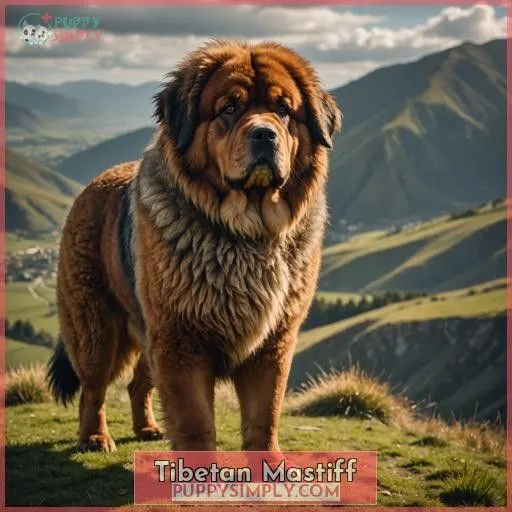This site is supported by our readers. We may earn a commission, at no cost to you, if you purchase through links.
Exploring the world’s most expensive dog breeds, you’ll uncover a realm of canine luxury and exclusivity.
The Tibetan Mastiff, with its imposing stature and lion-like mane, commands exorbitant prices due to its rarity and protective instincts.
The French Bulldog’s affectionate nature and popularity among enthusiasts contribute to its steep cost.
Breeds like the Löwchen and Canadian Eskimo Dog, facing extinction, are prized for their unique traits and heritage.
While prices soar, be prepared to invest in proper care and training for these coveted companions.
Discover the allure of these exquisite breeds as we reveal the compelling stories behind their grandeur.
Table Of Contents
Key Takeaways
- The Tibetan Mastiff, French Bulldog, Lowchen, and Canadian Eskimo Dog are among the most expensive dog breeds, each with distinct characteristics, health concerns, and grooming requirements.
- The Tibetan Mastiff is known for its imposing stature, lion-like mane, and protective instincts, while the French Bulldog is popular for its affectionate nature and popularity among enthusiasts.
- The Lowchen, a rare breed with a rich history, faces extinction and requires extensive care due to health issues and grooming challenges.
- The Canadian Eskimo Dog, with its robust Siberian heritage, is a symbol of endurance and faces health battles, making it a unique and cherished pet for those who value the legacy of dog breeds.
Most Expensive Dog Breeds
Venturing into the realm of canine extravagance, the top 20 priciest dog breeds provide more than a hefty price tag.
These breeds encompass the majestic Tibetan Mastiff and the uncommon Löwchen.
They come with distinctive health concerns, varying lifespans, and distinct temperaments.
Whether you’re captivated by the protective instincts of the Tibetan Mastiff or the allure of the Löwchen, it’s essential to grasp their grooming requirements, training needs, and potential health issues.
It isn’t merely about owning an expensive dog; it’s about ensuring a joyous and healthful life together.
Tibetan Mastiff
The Tibetan Mastiff, a rare and expensive dog breed, originates from Tibet. It is known for its imposing stature, lion-like mane, and protective instincts.
These dogs have a rich history. Nomadic tribes of the Himalayas bred them for livestock protection.
Tibetan Mastiffs are generally healthy, with an average lifespan of 10+ years. However, they can face health issues such as obesity, dental disease, and susceptibility to bacterial and viral infections.
They are highly protective of their home and family. Tibetan Mastiffs require an experienced owner for early and ongoing socialization and consistent training to prevent aggression and destructive behavior.
French Bulldog
French Bulldogs, with their adorable bat-like ears and charmingly flat faces, have captured the hearts of many.
Known for their affectionate nature, they’re a popular choice among dog enthusiasts.
French Bulldog puppies are often the center of attention, but their temperament and health are important considerations. Breeding and training play a key role in their development.
Adoption fees can vary, but it’s interesting to note how much these expenses accumulate over time.
Dog ownership is a commitment, and it’s vital to be aware of the responsibilities involved.
For those interested in rescuing pets, there are options available at rescuepets.com.
Löwchen
Löwchen, the little lion dog, is a rare breed with a rich history.
Originating in Germany, Löwchen was once a favorite of the nobility due to its small size and friendly temperament.
However, Löwchen’s rarity and unique appearance come with a price tag.
These dogs are known for their health issues, including hip dysplasia and dental problems, which can lead to high vet bills.
Grooming is also a challenge, as their long, silky hair requires regular attention.
Despite these challenges, Löwchens are affectionate companions, making them a popular choice for those seeking a unique and loyal pet.
When compared to other breeds, such as the Chow Chow, Samoyed, or Pharaoh Hound, Löwchen’s price is justified by its rarity and the care it requires.
Canadian Eskimo Dog
After diving into the luxurious world of the Löwchen, let’s venture further north to the Canadian Eskimo Dog.
This ancient breed, with its robust Siberian heritage, isn’t just about pulling carts but also about surviving in harsh climates.
Sadly, they’re skating on thin ice towards extinction, with fewer than 300 left.
Their health battles, including gastric torsion, entropion, and arthritis, underscore their resilience.
Despite these challenges, the Canadian Eskimo Dog remains a symbol of endurance, cherished by those who value the legacy of dog breeds.
Samoyed
The Samoyed, hailing from the unforgiving tundras of Siberia, has captivated dog enthusiasts worldwide with its imposing stature, striking appearance, and endearing Sammy smile. These friendly yet formidable canines, once employed as hunting companions and sled dogs by the Samoyedic people, have secured a coveted spot among the most expensive dog breeds due to their rarity, loyalty, and protective instincts.
Origin and History
The Samoyed breed, renowned for its distinctive white fur and amiable disposition, originated in the frigid expanse of Siberia, bred by the Samoyedic tribes. These native communities relied on these canines for herding reindeer, engaging in hunting pursuits, and transporting sleds across the arduous, snow-laden terrain. The breed’s dense coat provided protection against the bone-chilling temperatures, while its sociable and friendly nature made it an invaluable companion during the extended, harsh winters.
The Samoyed’s lineage is deeply entwined with its geographic distribution, with its roots tracing back to the Samoyede tribes of Siberia. These nomadic peoples shared an intimate bond with their canines, considering them integral members of their tribe. The breed’s cultural significance is evident in its role as a working dog, offering companionship and assistance in the demanding environments of Siberia.
Genetic diversity played a pivotal role in the Samoyed’s development, as the breed adapted to the diverse climates and terrains of its native region. This genetic diversity has contributed to the breed’s robust health and keen intellect, making it a versatile and adaptable working companion.
As the Samoyed gained recognition beyond its native region, breed enthusiasts implemented breeding programs to preserve and enhance its distinctive characteristics. The breed was officially recognized by the Kennel Club (UK) in 1909 and by the American Kennel Club (AKC) in 1906, with breed standards developed to accentuate its unique features, such as its dense, white coat, endearing Sammy smile, and gentle, adaptable temperament.
Despite its growing popularity as a show dog and family pet, the Samoyed has retained many of its original working dog traits, including its robust health, intelligence, and versatility. Today, the breed is cherished for its gentle nature and striking appearance, while maintaining its legacy as an indispensable working companion.
Imposing Stature
The Samoyed breed, one of the most expensive dog breeds, boasts an imposing size that exudes a majestic appearance.
These canine guardians, with their regal demeanor, are known for their protective nature, making them excellent pet care companions and even guard dogs.
Their imposing stature is a demonstration of their protective instincts.
They are a popular choice for those seeking a breed that embodies strength and loyalty.
Lion-like Manes
Behold the majestic presence of the Samoyed, a breed that boasts a lion-like mane, further enhancing its imposing stature.
This independent breed, with its ancient heritage tracing back to Tibetan origins, exudes a protective nature that is as enchanting as its lion-like appearance.
The Samoyed’s mane, a striking feature of its regal image, adds to its allure, making it a breed that commands respect and admiration.
Protective Instincts
As we explore the realm of the Samoyed, let’s unravel their protective instincts. These dogs are renowned for their fealty and unwavering dedication to their kin. Their aggression isn’t unfounded, as they’re fiercely defensive of those they hold dear. Training and obedience are paramount for these discerning dogs, ensuring they harness their protective instincts constructively.
Endearing Sammy Smile
The Samoyed’s endearing Sammy smile isn’t just a facial expression; it’s a symbol of their enduring popularity and loyalty. This breed standard feature, coupled with their size variation, makes them a versatile companion for any household. Here’s why they’re worth every penny:
- Their smile radiates warmth, inviting a sense of safety.
- Loyalty that strengthens the master-pet bond.
- Size variation accommodates different living spaces.
- Exercise requirements encourage a healthy lifestyle for owners.
Friendly Demeanor
Samoyed: The Friendly Demeanor
Samoyed puppies are known for their friendly and gentle nature. They’re adaptable dogs that can thrive in various environments and are often considered excellent companions for families. Their friendly demeanor is a result of their long history of living alongside humans in Siberia, where they were used for hunting, hauling sledges, and herding reindeer. This close bond with their human counterparts has made them highly loyal and devoted family dogs.
To make sure your Samoyed has a happy and healthy life, it’s important to provide them with regular exercise, mental stimulation, and socialization. These dogs are highly energetic and need a good amount of physical activity to stay healthy and happy. Additionally, they’re intelligent and responsive, making them easy to train with the right approach.
When considering a Samoyed puppy, it’s important to choose a reputable breeder who prioritizes the well-being of their dogs. This will help make sure that your new furry friend is healthy, well-adjusted, and well-prepared for a life of companionship with you and your family.
Here’s a table summarizing some key aspects of the Samoyed breed:
| Aspect | Description |
|---|---|
| Temperament | Friendly, gentle, and playful |
| Exercise | High energy, needs regular physical activity |
| Training | Intelligent and responsive, easy to train with the right approach |
| Socialization | Benefits from early exposure to various environments and experiences |
| Health | Generally considered a healthy breed, but prone to certain health issues |
Remember that every dog is unique, and individual experiences may vary. It’s important to provide your Samoyed with the proper care, attention, and training to help them live a long, healthy, and happy life with you.
Striking Appearance
The Samoyed’s striking appearance is an eye-catching blend of physical attributes, distinctive features, and visual appeal. Their lion-like manes, imposing stature, and protective instincts are matched by their endearing Sammy smile, friendly demeanor, and striking appearance. These aesthetic qualities contribute to their popularity and high demand, further influencing their price as one of the most expensive dog breeds.
Frequently Asked Questions (FAQs)
What are the health issues of the Tibetan Mastiff?
You’ll want to keep an eye out for hip/elbow dysplasia, thyroid issues, and bloat with the big-boned Tibetan Mastiff. Their gigantic size also predisposes them to congenital heart defects.
How long does a French Bulldog live?
You’re wondering about the French Bulldog’s lifespan? Well, these adorable companions typically live around 10-12 years with proper care. Their compact size contributes to a reasonably long life, provided you manage any potential health issues.
What is the origin of the Löwchen?
Oh, you’re interested in the Löwchen’s origins? Well, let me satirize your desire for an expensive breed – this little lion dog actually hails from Germany and France. Its rarity adds to the cost, but its charm is priceless.
What are the health issues of the Canadian Eskimo Dog?
You’ll face gastric torsion, entropion (eyelids rolling inward), heat intolerance, and arthritis with a Canadian Eskimo Dog. This hardy breed has unique health challenges due to its Arctic roots.
How much does a Samoyed cost?
Like a mystical snow creature from the far north, a Samoyed’s price tag ranges from $2,500 for a companion to over $10,000 for a show-quality pup. Their cheerful smiles belie the sizable investment required to bring one home.
Conclusion
Ultimately, the universe of the most expensive dog breeds captivates with its exclusivity and grandeur.
You’ve explored their unique traits, from the Tibetan Mastiff’s regal presence to the Samoyed’s endearing smile.
While securing one demands substantial investment, these companions offer unparalleled companionship and a connection to canine heritage.
Embracing the allure of these coveted breeds opens doors to a realm of luxurious canine companionship.












